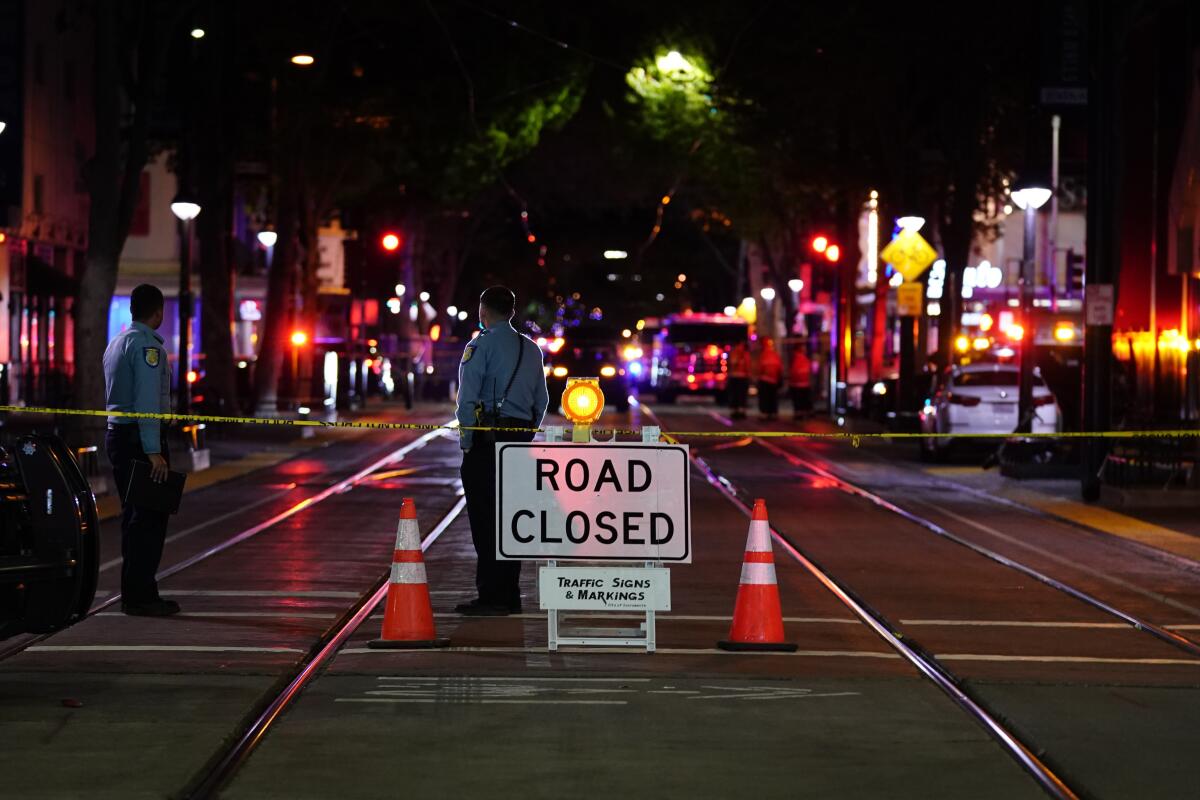The Sacramento shooting escalated American violence. We know how to shut it down again

- Share via
Johntaya Alexander did her big sister a favor early Sunday morning, showing up to give her a ride home when the downtown Sacramento clubs closed at 2 a.m. Minutes later, 21-year-old Johntaya, who dreamed of becoming a social worker, lay dying in her sister’s arms, cut down by gunfire that killed five others and wounded a dozen more.
As Sacramento police continue to investigate a shooting described as the worst in the city’s history, authorities elsewhere in the country face the same grim task. During a single incident in Dallas last weekend, 11 people were shot and one killed. Across Chicago, two people died and 17 others were wounded. Still more victims perished from gunfire in Baltimore, San Francisco, Albuquerque and other cities.
And it’s not summer yet, the time when shootings reach a crescendo nationally, as warm weather brings more people outside and conflicts can escalate, with often deadly results.
Gun violence has been on the rise in the United States since 2020, when the pandemic, social unrest and surging gun sales combined to cause homicides to spike by nearly 30%, the largest single-year increase in recent history. In 2021, the numbers rose by another 5%, and the trend appears to be continuing in 2022.
What can be done? Unfortunately, the hyperpartisan politics gripping Washington means progress at the national level will be slow. But cities and states can take constructive action on their own.
Last summer, the Council on Criminal Justice convened a Violent Crime Working Group, to research evidence-based, local solutions for the problem of rising gun violence in the U.S. The group — made up of 16 leaders from violence intervention organizations, law enforcement, the public health sector and academia — outlined an approach to reducing violence that leaders can set in motion quickly, without the need for large expenditures or new legislation.
They must:
• Get focused. Set a concrete goal and commit to saving lives by reducing violence. Experts agree that an annual 10% reduction in killings and shootings is an ambitious yet achievable target.
• Get educated. In city after city, gun violence is concentrated among a surprisingly small number of people, groups and locations. Effective violence reduction must begin with a rigorous “problem analysis” to identify those people and places. Operation Ceasefire in Oakland confronted such high-risk individuals and groups with a double message of empathy and accountability, and the initiative cut firearm homicides in that city by 31% over seven years.
• Create a concrete, multidimensional plan for focusing efforts where violence is most concentrated. In 2019, Dallas launched its Task Force on Safe Communities. The city began a place-based effort to remove blight, improve lighting and deploy street mediators in areas with the greatest violence. In 2021, violent crime dropped 9%.
• Rely on the community as well as the science. The most effective anti-violence strategies are steeped in credible research and consultation with those most affected by crime in their daily lives.
• Stay balanced. Police and prosecutors have to hold violent perpetrators accountable, but that’s not enough. Street outreach workers, treatment and service providers, community leaders and others must also work to prevent violence before it happens. Reducing violence is a team sport, and all the community’s players must get involved.
• Finally, place responsibility for violence reduction at the top. Every city suffering from high rates of violent crime should have a permanent department dedicated to violence reduction within the mayor’s office, with senior leadership reporting directly to the mayor. These departments can put intervention programs and workers into neighborhoods, administer funding and act as a hub for anti-violence work — but they must be sustainably staffed and substantially funded with support from state and federal grants.
The Sacramento shootings that ended Johntaya Alexander’s life set a record nationally in terms of deaths and injury so far this year, and sadly, we know it won’t be the last such incident. Violent crime is a deadly serious challenge, but we’re not helpless. If we demonstrate courage and commitment, engage communities and rely on effective, proven strategies, we can save lives.
Thomas Abt is a gun violence expert and senior fellow at the Council on Criminal Justice. He chaired the council’s Violent Crime Working Group.
More to Read
A cure for the common opinion
Get thought-provoking perspectives with our weekly newsletter.
You may occasionally receive promotional content from the Los Angeles Times.









